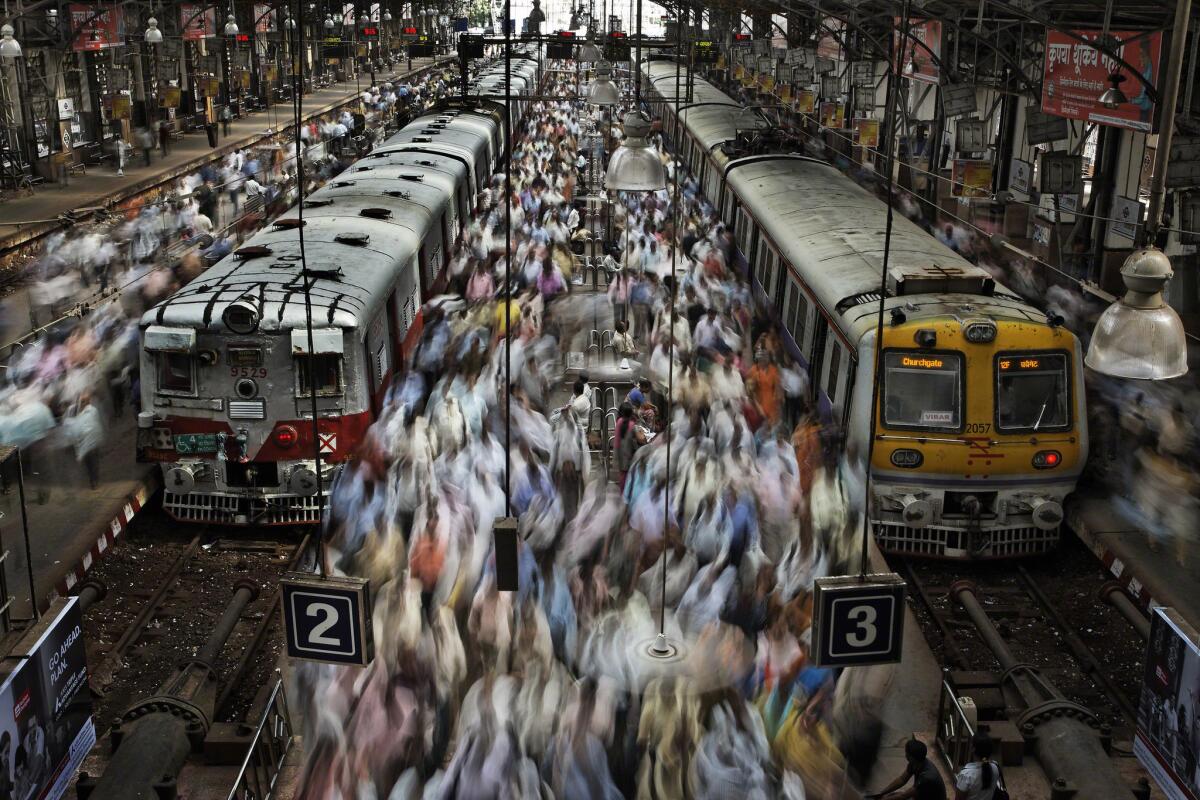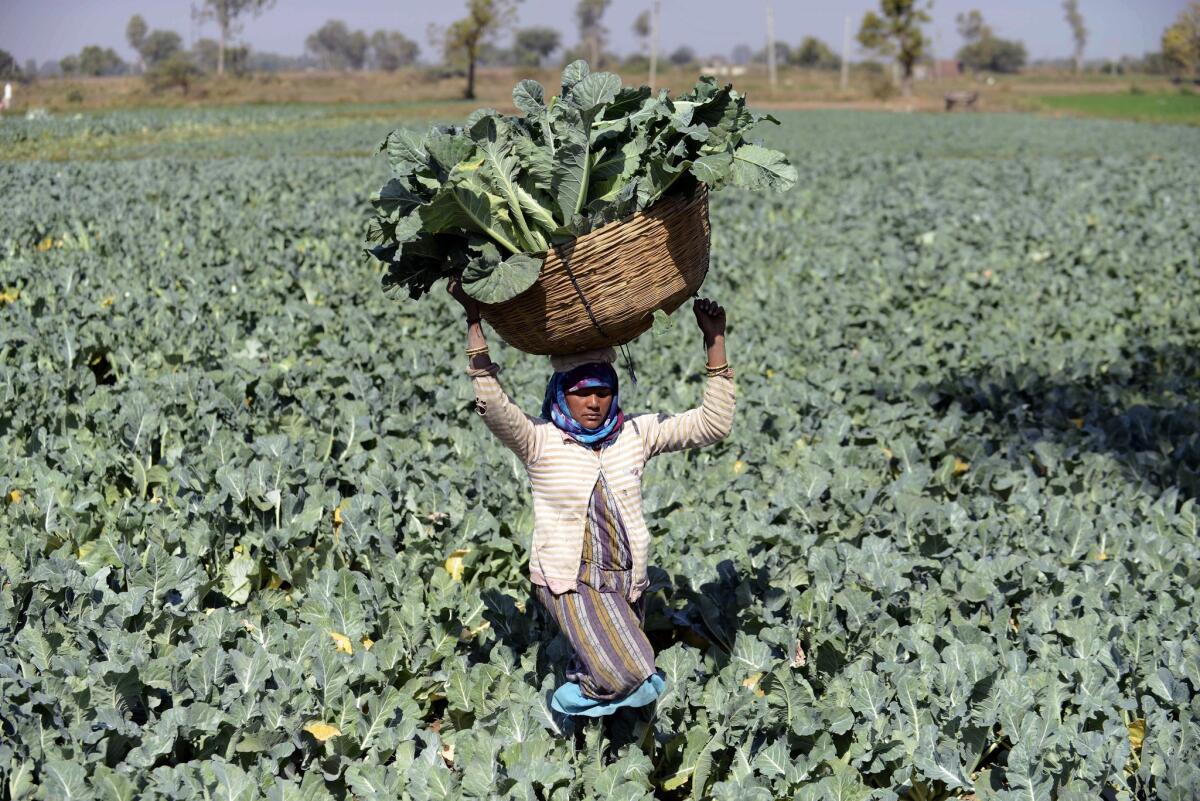Urban population growth and demand for food could spark global unrest, study shows

Travelers pack Churchgate Railway Station in Mumbai, India. Mumbai is among the cities worldwide where a population explosion is forecast to take place between 2025 and 2050, according to one report.
- Share via
A population explosion in urban centers around the world is expected to fuel an unprecedented demand for food that – if not met – could trigger economic upheaval and civil unrest on a global scale, according to a study published by the Chicago Council on Global Affairs.
“Growing Food for Growing Cities” forecasts that two-thirds of the world’s population, 6.3 billion people, will be squeezed into the cities by 2050 and that global food production would have to increase 50% to 60% to keep everyone fed. The world’s urban population now stands at 3.9 billion, according to the United Nations.
“The threat is, will there be enough food produced for those people living in cities?” said Dan Glickman, a former U.S. secretary of Agriculture and co-chair of the council’s advisory group on the study. “Will the supply chains to get the food to the urban areas be adequate to feed the people, and if not, will there be political and economic dislocation? It’s a very, very serious problem and not enough people have been talking about it.”
In order to meet an increased demand in growing cities, the system by which food is produced, processed and delivered will need to change, the report says. And that transformation must target the food supply network in low- and middle-income countries, especially those in Asia, Africa and Latin America where feeding urban populations has become an urgent and critical challenge, according to the study.
The proof is in the raw numbers, said Thomas A. Reardon, the study’s principal author. Anywhere from half to 70% of a nation’s food supply is consumed in urban areas, and as much as 90% of the food in developing countries comes from domestic sources, such as local farms.
”So when we’re talking about supply chains, we’re talking about the rural-to-urban supply chains on which cities depend,” Reardon said.
Cities such as Mumbai in India, Lagos in Nigeria, and Tanzania’s Dar es Salaam are among the places where a population explosion is forecast to take place between 2025 and 2050, according to the report. With the exception of a few countries, such as China, roughly 75% of the urban growth has been “organic” or the result of new births in cities and the reclassification of growing rural areas as urban.
“As more and more farmers leave the farms and move into urban areas, it’s going to create a tremendous burden to feed the people in those countries,” Glickman said.
In the last 20 to 30 years, the amount of food being transported from rural to urban areas has increased 300% in India, 800% in Africa and 1,000% in Southeast Asia, Reardon said.
“This gives you an indication of how massive the supply chains have to be to supply these vast needs of food for the cities,” he said.
To meet future demand, the food delivery system would need to become more efficient and develop and expand to encompass more farmers even in more remote areas, the study says.

An Indian farmer hoists a harvest of cauliflower in the village of Rasalpur. A study published by the Chicago Council on Global Affairs forecasts that global food production would have to increase 50% to 60% to keep everyone fed.
There is a bright side to the potential crisis. The skyrocketing demand could provide an opportunity to raise the incomes of rural and small-scale farmers as they are pressed to grow higher-value products such as fruits and vegetables that are favored by urban dwellers, whose diets have become more diversified, according to the study. Expanding the supply chain could also be profitable for rural enterprises along the route, including wholesalers, transporters, processors and suppliers.
“Developing the food systems that link farmers to cities will have an enormous impact on rural poverty alleviation and agricultural development,” the report says.
But achieving this would also involve other factors such as infrastructure development and ensuring there is adequate refrigeration and storage for perishable products along the route, Reardon said.
The report urges the U.S. to lead global efforts to promote agriculture and food security in low- and middle-income nations by doing everything from supporting private-sector investment to promoting policies that strengthen research on efficient and sustainable food chains.
Success in transforming the world’s food system would also require governments in the developing world to be positive players, Glickman said. Good governance, rule of law and legitimate contracts, Glickman said, are key to attracting the support and financing of multinational corporations.
ALSO
Senate finally confirms new U.S. ambassador to Mexico
Ukraine remembers Chernobyl nuclear power plant explosion 30 years later
Muslim world sharply divided on Koran’s influence on government law, poll finds
More to Read
Sign up for Essential California
The most important California stories and recommendations in your inbox every morning.
You may occasionally receive promotional content from the Los Angeles Times.











